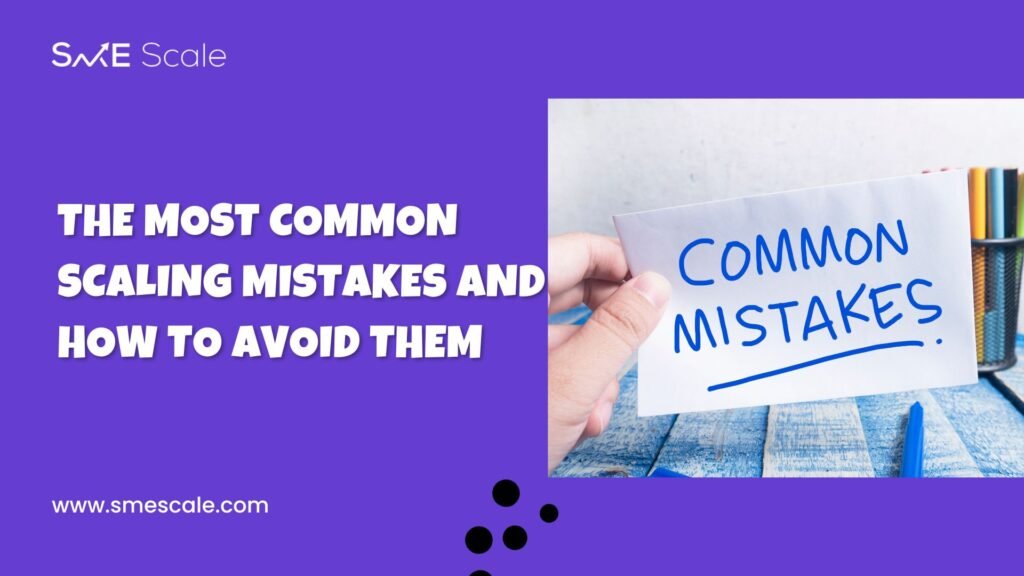The Most Common Scaling Mistakes and How to Avoid Them: Lessons from Real SMEs

As a small or medium-sized enterprise (SME), achieving growth is exhilarating — but scaling too fast or in the wrong way can be a silent killer. At SME Scale, we’ve helped countless businesses navigate the complexities of expansion using proven data-driven strategies. In this post, we’ll break down the most common scaling mistakes SMEs make, show you how to avoid them, and offer a real-life case study that reveals powerful marketing methods and the psychology behind successful scaling.
🚫 Mistake #1: Scaling Without a Clear Growth Blueprint
One of the most common scaling mistakes is jumping into new markets or expanding product lines without a structured plan. Growth without direction is just activity — not progress.
What to do instead:
Develop a clear Growth Blueprint that outlines your goals, timelines, customer segments, operational capacities, and success metrics. This strategic approach, central to SME Scale’s framework, ensures every decision contributes to long-term scalability.
💡 Psychological Insight: Uncertainty breeds anxiety — both in leadership and within teams. A strategic plan reduces cognitive overload and supports better decision-making.
🚫 Mistake #2: Ignoring the Power of Customer Data
Many SMEs expand operations without truly understanding their customer base. This results in misaligned marketing, poor retention, and underwhelming ROI.
What to do instead:
Use data analytics to track customer behavior, segment audiences, and personalize campaigns. SME Scale leverages data science tools to predict churn, identify high-LTV customers, and refine messaging.
💬 Psychological Insight: Personalization taps into the reciprocity bias — when customers feel understood and valued, they’re more likely to engage and convert.
🚫 Mistake #3: Expanding Without Market Adaptation
Scaling a product that works in one region doesn’t guarantee success in another. Cultural, economic, and behavioral differences can break a scaling effort.
What to do instead:
Apply Market Adaptation Strategies. Before launching into new geographies, run targeted surveys, test messaging, and adapt pricing strategies based on local behavior.
✅ Case Study: How “Bark & Bone” Scaled Nationally (Without Losing Their Woof)
Background:
Bark & Bone, a regional dog treat company based in Leeds, saw explosive growth in their local market. Encouraged by success, they aimed to scale nationally — but faced declining engagement and increasing returns from new regions.
The Turning Point:
SME Scale partnered with Bark & Bone to conduct a deep customer behavior analysis. The data revealed:
Southern UK customers responded more to eco-friendly packaging.
Northern buyers preferred bulk buying options for multi-dog households.
Website traffic dropped when content lacked regional references.
Marketing Method Applied:
We segmented the customer base by geography and behavior. Then, we launched localized digital campaigns with region-specific branding and offers. Email sequences were rewritten with customer-centric copy based on psychographic insights.
Results:
31% increase in conversion rate across new regions
21% decrease in return rates through better product-market fit
48% boost in customer loyalty scores within 3 months
🧠 Why it worked: These changes aligned with behavioral consistency — when marketing mirrors customer identity, trust is built faster and conversion accelerates.
🚫 Mistake #4: Scaling with Fragile Operations
Many SMEs focus all their energy on sales growth without considering operational infrastructure — from staffing and supply chains to logistics and support.
What to do instead:
Before scaling, assess and digitally transform your backend systems. Automate what can be automated, upskill your team, and ensure your tech stack is ready to handle increased demand.
💡 SME Scale Tip: A scalable business is one where operations can grow without exponentially increasing cost or complexity.
🚫 Mistake #5: Underestimating Customer Loyalty
Acquiring new customers is costly. Yet, many SMEs neglect existing customers while chasing new ones.
What to do instead:
Create a Customer Loyalty Roadmap — implement referral incentives, personalized offers, and consistent communication. Remember, loyalty isn’t built through discounts alone — it’s built through value and connection.
🧠 Psychological Insight: Humans are emotionally driven. Brands that invest in emotional resonance foster long-term loyalty.
Conclusion: Scale Smarter, Not Just Bigger
Scaling a business is a thrilling milestone, but one wrong move can cost more than just revenue — it can erode brand trust and operational efficiency. By avoiding these common mistakes and embracing data-driven, psychologically informed strategies, SMEs can scale in a way that’s sustainable, profitable, and aligned with their core values.
At SME Scale, we specialize in helping businesses do just that. From building your Growth Blueprint to mastering digital transformation, we’re your partner in smart, strategic expansion.
🧩 Ready to scale without the stumbles?
Let SME Scale guide your journey.
📞 Call us at +44 7546 144673 or visit smescale.com to book a consultation today.


